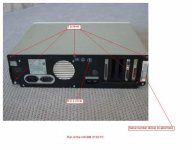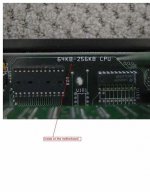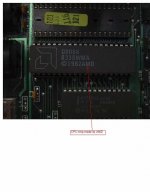Lorne
Veteran Member
There is stuff all over this forum regarding the differences between early and later model IBM 5150’s, and I’m sick of going all over the place looking for it.
I’ve started this thread in the hopes of getting it all into one place.
I want to get pictures and descriptions of what the differences are, all in one place, and as you’ll see below, I’ve got some of them covered.
The part I’m having problems with, is the floppy drives but I want to know about the other differences as well.
Modem7 says he has an early 5150 but “it has a second edition ROM (U33=5700671)”.
I’m not sure what that means.
He also says: "the xt guy" on these forums has a 5150 with a first edition ROM. On his unit, "the date on the inside of the front cover is 01-82". I find nothing that looks like a date in the case of my unit.
I can’t find a date on the inside of my early (1.00 ROMs) front cover eiither.
The later version 5150’s had a build date tag on the speaker wires. Mine doesn’t have that. Was that only attached on the later versions?
The early versions also had a hole in the case under the power supply, which the later versions didn’t seem to have.
Another question is whether the disk drives had IBM logos on the drives or not.
Does anyone have a photo (of decent resolution) issued at the time of the 5150 release, that might give some indication as to whether the drives had logos or not?
I’ve heard that the very first 5150’s didn’t have the logo drives because of supply problems, but then I’ve also heard the opposite.
Could all those who have experience and knowledge with these early 5150’s please chime in?
Once I’ve got all the comments, I’ll post a reply summarizing all the info (with photos as applicable), so we’ll have it all in one place.
Thanks,
Lorne
Here's what I've got so far for identifiers on the IBM 5150 PC (16KB-64KB CPU)
(IBM 5150 PC (64KB - 256KB CPU) - photos on next post)
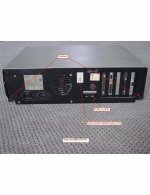
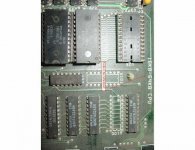

I’ve started this thread in the hopes of getting it all into one place.
I want to get pictures and descriptions of what the differences are, all in one place, and as you’ll see below, I’ve got some of them covered.
The part I’m having problems with, is the floppy drives but I want to know about the other differences as well.
Modem7 says he has an early 5150 but “it has a second edition ROM (U33=5700671)”.
I’m not sure what that means.
He also says: "the xt guy" on these forums has a 5150 with a first edition ROM. On his unit, "the date on the inside of the front cover is 01-82". I find nothing that looks like a date in the case of my unit.
I can’t find a date on the inside of my early (1.00 ROMs) front cover eiither.
The later version 5150’s had a build date tag on the speaker wires. Mine doesn’t have that. Was that only attached on the later versions?
The early versions also had a hole in the case under the power supply, which the later versions didn’t seem to have.
Another question is whether the disk drives had IBM logos on the drives or not.
Does anyone have a photo (of decent resolution) issued at the time of the 5150 release, that might give some indication as to whether the drives had logos or not?
I’ve heard that the very first 5150’s didn’t have the logo drives because of supply problems, but then I’ve also heard the opposite.
Could all those who have experience and knowledge with these early 5150’s please chime in?
Once I’ve got all the comments, I’ll post a reply summarizing all the info (with photos as applicable), so we’ll have it all in one place.
Thanks,
Lorne
Here's what I've got so far for identifiers on the IBM 5150 PC (16KB-64KB CPU)
(IBM 5150 PC (64KB - 256KB CPU) - photos on next post)




